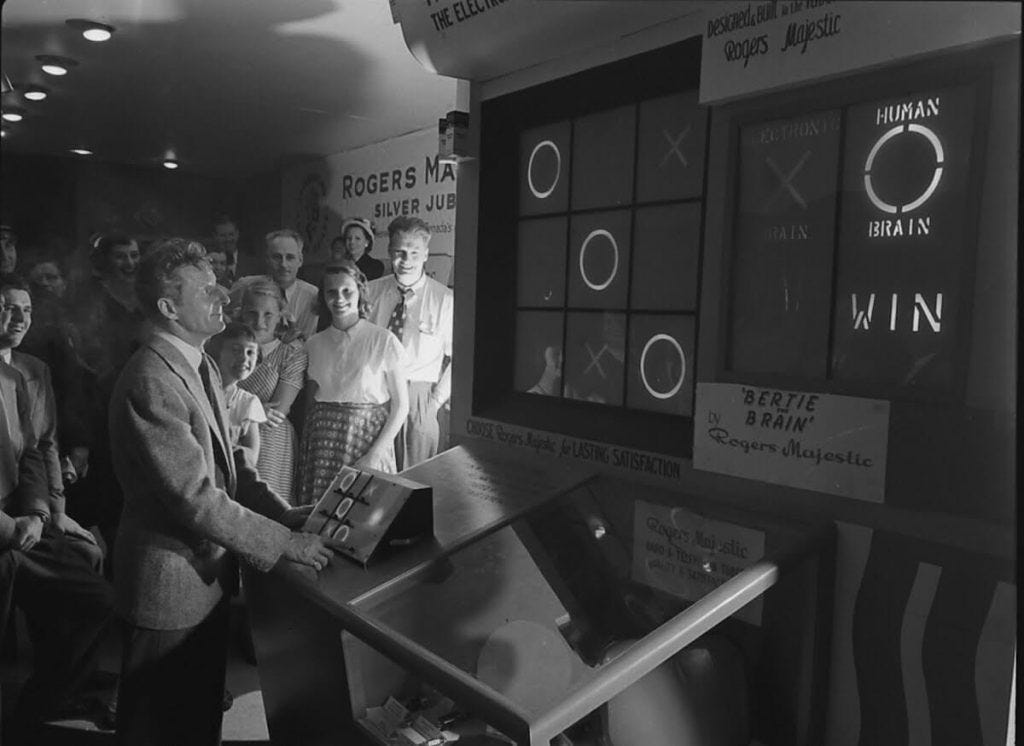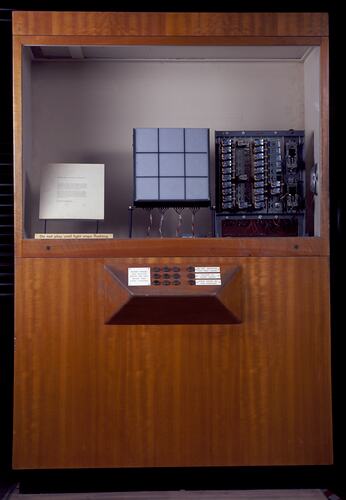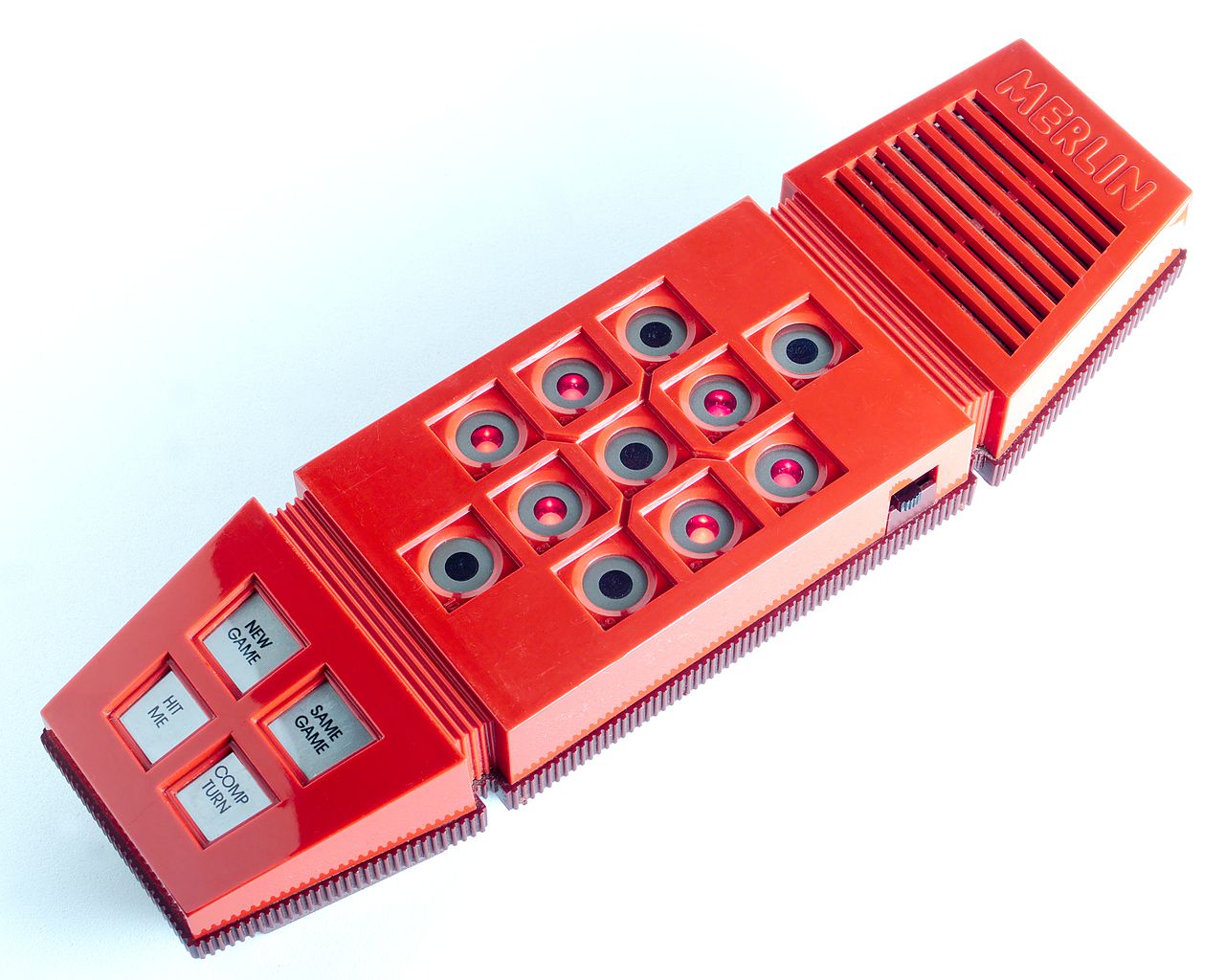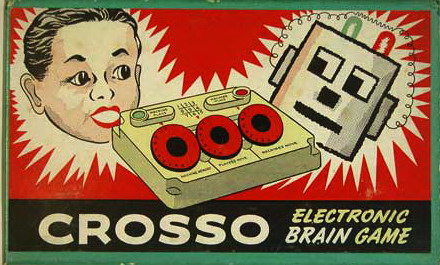In a previous posting I did a little dive into three relay based tic-tac-toe machines that were made in 1949 / 1950. These seem to have kick started development of many similar machines, and I thought it might be interesting to try to put together a bit of a timeline of interesting tic-tac-toe machines. When I've (inevitably) missed a good machine, please leave a comment with a link to it and I'll try to add it to the timeline.
Frank Freeland
The first documented tic-tac-toe machine appears to have been constructed by Frank Freeland in 1878. This was a mechanical design documented in the paper "An Automatic Tit-Tat-To Machine" found in the January 1879 Issue of the Journal of the Franklin Institute.
Davies, Haufe and Keister Machines
Constructed in 1949, 1949 and 1950 respectively these are three very early relay based machines. More information on them can be found in my previous post.
CROSSO Electronic Brain Game
The CROSSO Electronic Brain Game is a very early electric noughts and crosses opponent sold by Nombrex Limited from Somerset, England. The computer opponent was made entirely of switches and lamps and was powered by a single 3V dry battery cell. Very little information is available on the machine and they seem to be pretty rare, but it is believed to have been produced in the late 1940s or early 1950s (the aesthetic looks to be more 1950s than 40s to me).
Bertie the Brain
Josef Kates put together Bertie the Brain in 1950, making it another contemporary of Davies, Haufe and Keister. I didn't talk about it in the previous post because Bertie was constructed of tubes / valves rather than relays. In fact, Bertie was constructed as a demonstration of Kates' new "additron tube", and the machine was demonstrated at the Canadian National Exhibition in late August 1950.
 |
| Bertie the Brain |
EDSAC OXO
Alexander Douglas developed OXO, one of the first video games in 1952. OXO simulated noughts and crosses on the EDSAC computer at Cambridge University. The game provided an opponent for a one player game and implemented a perfect strategy. The current position was displayed graphically on a CRT and ser input was taken from a rotary telephone dial. A version of OXO can be found in the EdsaLx emulator distribution, although this is assumed to be a modern recreation, rather than the original program.
Chris Burton
In issue 11 of Resurrection, the journal of the Computer Conservation Society, Chris Burton claims to have made a relay noughts and crosses machine in 1952. Nothing else is known about the machine.
Eric Foxley
On his biographical page, Eric states that he constructed a noughts and crosses machine in 1953, building on earlier work putting together a machine that played Nim. Talking to Eric he says that his machine was mainly constructed of relays. He also mentions that he demonstrated the machine at local school fetes.
 |
| Harris Morgan's Machine |
Harris Morgan
The June 1953 issue of Practical Mechanics contained an article by Harris Morgan detailing the construction of a tic-tac-toe machine based around a rotary switch. Interestingly the player drops ball bearings into holes in order to make moves on this machine. This project seems to have been updated by R.K. Johnson, replacing the ball bearing input scheme with a stylus and brass washers. It was then published in the October 1972 issue of Practical Electronics.
GENIAC
GENIAC was an educational toy designed by Edmund Berkley and Oliver Garfield and sold from 1955 onward. It was a construction kit based around six rotary switches and was marketed as an "Electronic Brain Construction kit". Starting in 1956 GENIAC adverts claimed that it is possible to construct Nim and tic-tac-toe playing machines using the kit.
Bob Cadwell
An amazing picture from Getty Images suggests that Bob Cadwell constructed a hybrid valve and relay based tic-tac-toe machine. Bob pointing at a CRT might suggest it displayed its output on a TV screen. However, the internet seems skeptical that the tubes in the left hand chassis and CRT were connected and operational when this picture was taken. So perhaps Bob's machine actually comprises the chassis containing 54 relays and switch box in the centre of the image. It seems the machine was demonstrated at the Illinois Junior Academy of Science in May 1956. Unfortunately, this one picture appears to be the only documentation of this machine.
 |
| Bob Cadwell's Machine |
Relay Moe
The cover of the December 1956 issue of Radio Electronics declared that "Relay Moe Plays Tick-Tack-Toe" next to a picture of a man sitting in front of a coloured 3x3 grid and next to tic-tac-toe next to a rack of relays. It seems that Moe was built by Berkley Enterprises and could be played by appointment at the New York lab. The article inside gives and overview of the machine's operation, and states that its unique feature was that it was the first machine to have variable strategies. Unfortunately, this statement was incorrect, as seven years earlier the Haufe machine had a switch that prevented optimal play.
Tic-Tac-Toe Mate
The November 1958 issue of Popular Electronics carried an article by David Lockhart that detailed the construction of a switch and lamp tic-tac-toe opponent called the Tic-Tac-Toe Mate. Readers could build the manually operated machine using 80 slide switches and 19 lamps.
MENACE
The Matchbox Educable Noughts and Crosses Engine, or MENACE was developed by Donald Michie in 1961. Unlike the other machines listed here MENACE did not have a fixed algorithm embedded in it, instead it learned how to beat its human opponents through repeated play. As such, it was an important stepping stone in the development of AI through reinforcement learning. Not only that, but its entire construction consisted of approximately 1500 coloured beads placed in 304 empty matchboxes. No lamps, no relays, no switches, nothing. This is an amazing invention and well worth your time reading about, and Matt Parker has done a really good video on it.
G E Dunning
In September 1965, Practical Electronics carried an article by G E Dunning describing another switch and lamp machine, similar to the Tic-Tac-Toe Mate. In this instance the machine was built using 19 rotary wafer switches and 18 lamps. Again, full instructions to build the machine are provided.
 |
| Roy Hartkopf's Machine |
Roy Hartkopf
The Museums Victoria Collection contains a relay based machine constructed by Roy Hartkopf between 1963 and 1967. It's likely this is a contemporary of the Computox, and like it is constructed of telephone exchange parts. The museum's website has a picture of the machine being played at the Science Museum of Victoria in 1968.
Brian Healy
The April 2009 issue of Everyday Practical Electronics carried an article by Brian Healy on page 22. This detailed the construction of an Arduino based tic-tac-toe machine, named Oscar. However, Oscar was based on an earlier machine, also called Oscar, that Brian built in the late 1960s. According to Brian, his earlier design used approximately 70 relays and a uniselector. The article has an image from the Wollongong Mercury showing the original Oscar being played in 1968.
British Amateur Electronics Club
The British Amateur Electronics Club was founded in 1966 and one of the first projects its members worked on was a noughts and crosses machine, starting in 1967. It seems this was described in some detail in the club's newsletters, presumably with the intent that members could build and refine their own examples. Unfortunately, the relevant newsletters are not archived online. At least one machine seems to have been built and this was demonstrated by the club at events until at least the mid-70s.
Waco Electro Tic-Tac-Toe
The Electro Tic-Tac-Toe was a handheld noughts and crosses game released in 1972. I mention it because it's often cited as the first handheld electronic game. This is total bunk. Currently that honour is believed to go to Auto Race by Mattel, which was released in 1976 (although it's surprising to me that there were no transistor, diode or relay based games released prior to the microcontroller based Auto Race). As can be seen in this excellent video, Electro only consists of nine lamps that appear to be turned on by contacts and are obscured by an opaque black mask or shine through a transparent red or green filter to show moves. It mechanically records moves made between two human players. There are no electronic components, it does not provide an opponent or assess winning positions. As such, it is substantially more primitive than CROSSO and the other machines listed here.
BASIC Computer Games
David Ahl first published his book BASIC Computer games in 1973 whilst working for DEC. It contains two tic-tac-toe games that could be typed in and run on most 8-bit computers. The first, written by by Tom Koos and Steve North, was designed to be used on a teletype as it saved paper by not printing the game board. The second version was designed for a CRT terminal and did draw the board. Unfortunately, its author is unknown.
Herb Cohen
The 1976 Popular Electronics Experimenter's Handbook contains the design of a tic-tac-toe machine built using diodes and transistors. The machine uses a stylus and conductive touch pads to make moves, rather like a Stylophone. The article includes a PCB layout from which the machine can be made.
 |
| Herb Cohen's Machine |
Daniel Hillis and Brian Silverman
Although not an electronic, or even electrical opponent, Hillis and Silverman's Tinker Toy tic-tac-toe computer is well worth a mention. Originally constructed in 1978 when they were sophomores at MIT, the machine is entirely mechanical, displaying its results using wooden flags. The write up of Hillis and Silverman's work in the October 1989 edition of Scientific American, suggests a second machine was built in 1979. Although the original Tinker Toy machine was built 100 years after Freeland's first mechanical tic-tac-toe opponent, the two machines are believed to be unrelated. Like the Keister machine, the Tinker Toy computer is now part of the Computer History Museum collection.
Joe / Hobby Electronics
Joe's late brother created a CMOS based tic-tac-toe machine in 1978. Joe found documentation of the machine and made it available in 2020. The machine was built from 188 discrete logic gates distributed across 66 4000 series CMOS ICs.
Parker Brothers Merlin
Parker Brothers released the Merlin handheld game in 1978 for the princely sum of $35 (approximately $170 in 2025). According to Wikipedia more than 5 million Merlins were sold. Amongst its six games was a tic-tac-toe opponent. Merlin was designed by former NASA employee Bob Doyle, his wife Holly, and brother-in-law Wendl Thomis. Like many other toys of the era including Simon, Big Trak and the Microvision (but not Mattel's Auto Race), it was based around a Texas Instruments TMS1x00 microcontroller, in this case the TMS1100.
 |
| Parker Brothers Merlin |
Possible Computox Relatives?
Of the machines listed here, most are not described in enough detail to know whether they are a close relative of the Computox. Those that are described well, such as the projects in electronics magazines, clearly aren't related as they are based purely on switches and lamps. There are still some possibilities, such as the machine constructed by the British Amateur Electronics Club, but nothing concrete at the moment.



Comments
Post a Comment